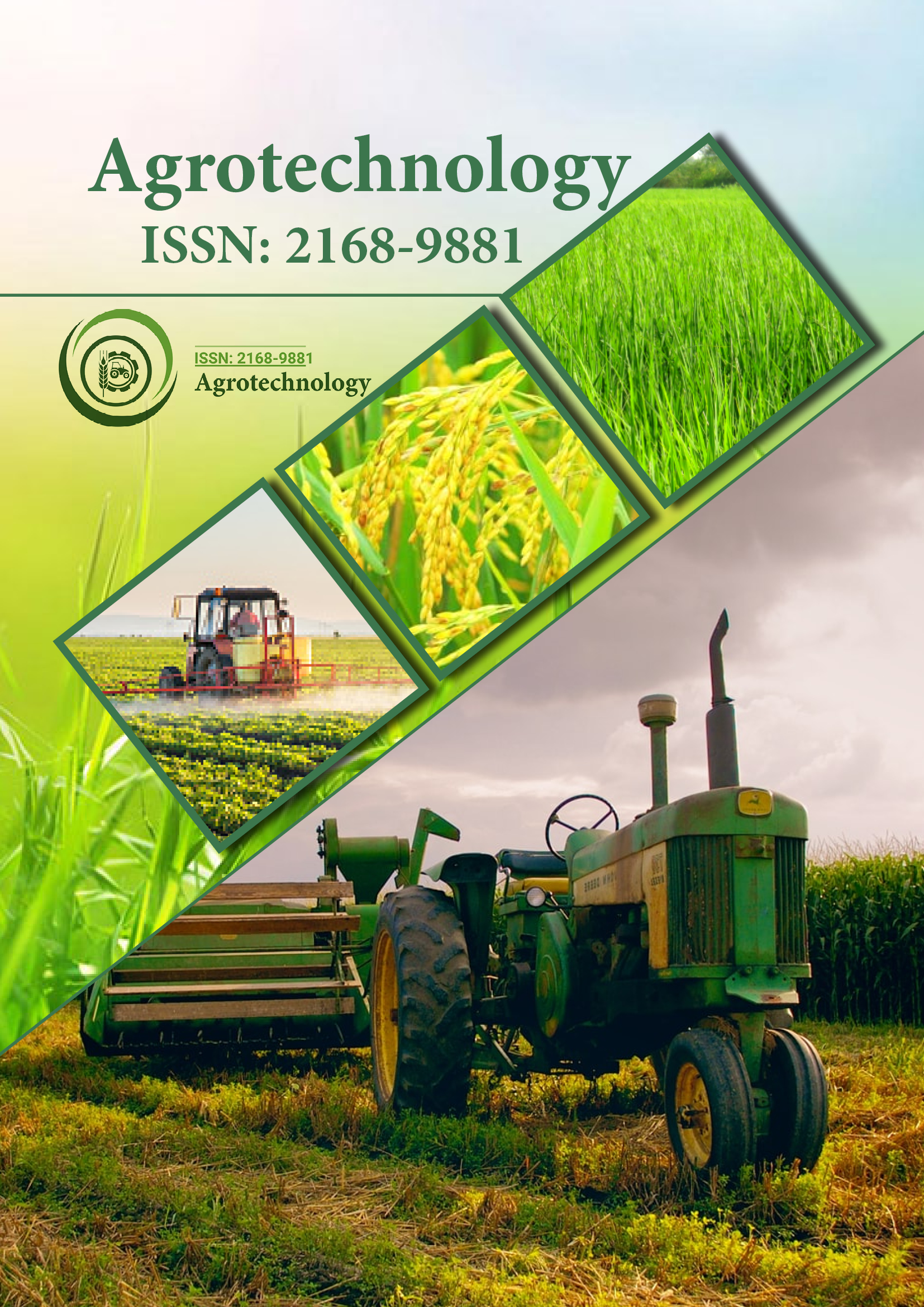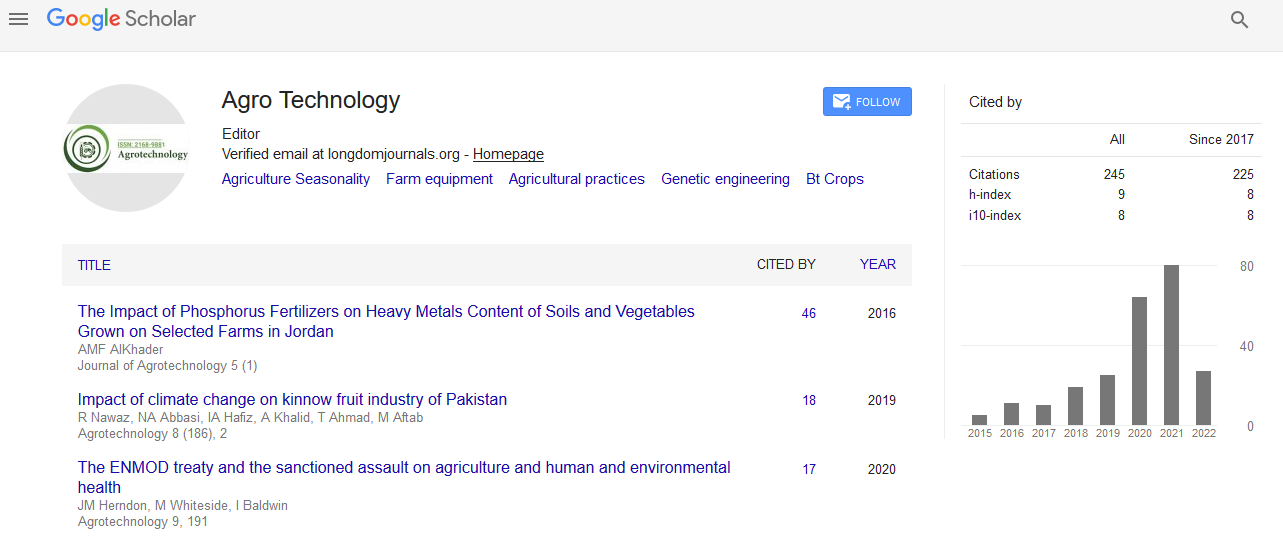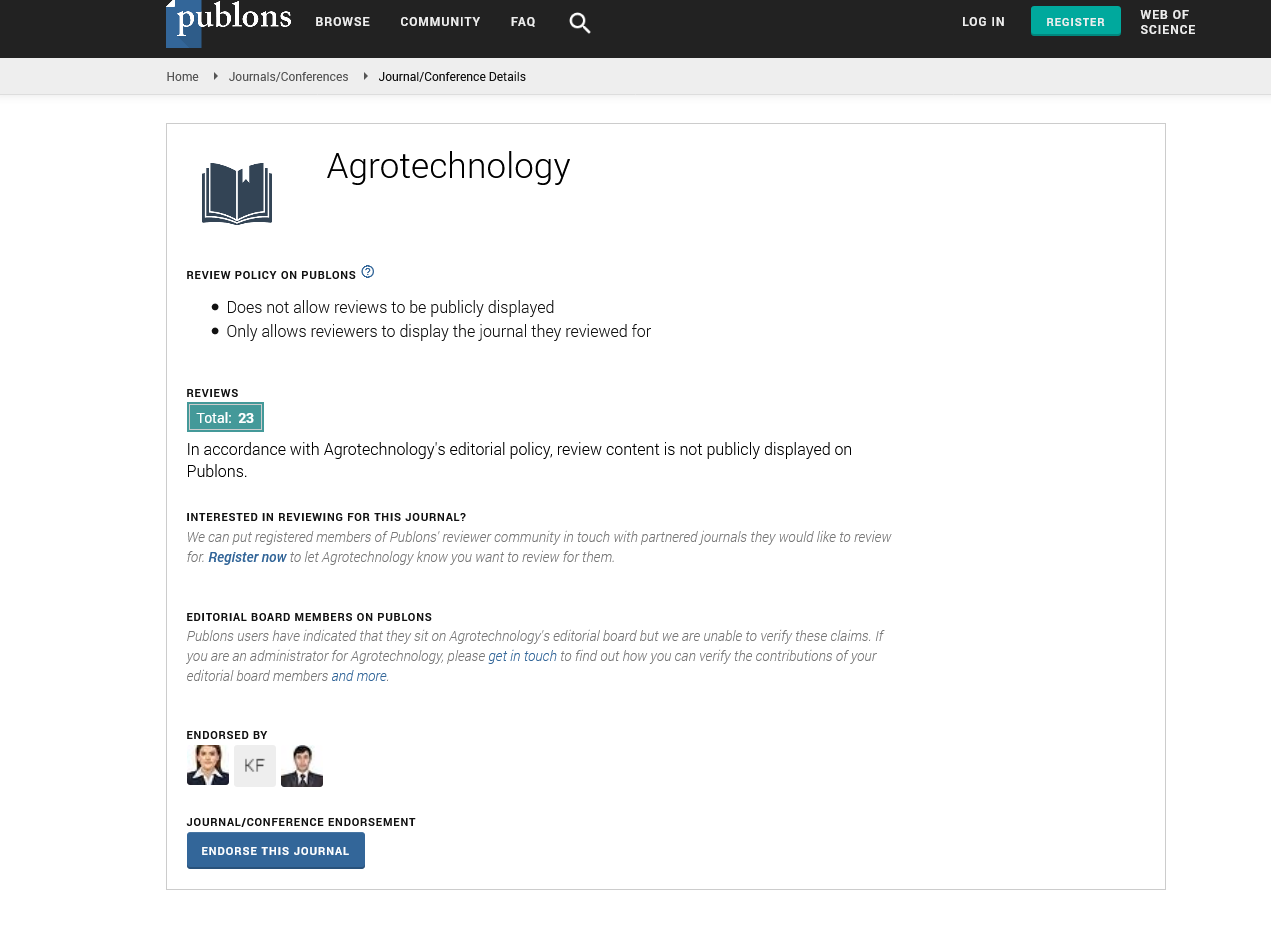Indexed In
- Open J Gate
- Genamics JournalSeek
- Academic Keys
- ResearchBible
- Cosmos IF
- Access to Global Online Research in Agriculture (AGORA)
- Electronic Journals Library
- RefSeek
- Directory of Research Journal Indexing (DRJI)
- Hamdard University
- EBSCO A-Z
- OCLC- WorldCat
- Scholarsteer
- SWB online catalog
- Virtual Library of Biology (vifabio)
- Publons
- Geneva Foundation for Medical Education and Research
- Euro Pub
- Google Scholar
Useful Links
Share This Page
Journal Flyer

Open Access Journals
- Agri and Aquaculture
- Biochemistry
- Bioinformatics & Systems Biology
- Business & Management
- Chemistry
- Clinical Sciences
- Engineering
- Food & Nutrition
- General Science
- Genetics & Molecular Biology
- Immunology & Microbiology
- Medical Sciences
- Neuroscience & Psychology
- Nursing & Health Care
- Pharmaceutical Sciences
Commentary - (2025) Volume 14, Issue 1
Addressing Pathogen Pollution and Climate Change in Plant Health
Rachel Greenfield*Received: 19-Feb-2025, Manuscript No. AGT-25-28740; Editor assigned: 21-Feb-2025, Pre QC No. AGT-25-28740 (PQ); Reviewed: 07-Mar-2025, QC No. AGT-25-28740; Revised: 14-Mar-2025, Manuscript No. AGT-25-28740 (R); Published: 21-Mar-2025, DOI: 10.35248/2168-9891.25.14.395
Description
Emerging Infectious Diseases (EIDs) of plants are rapidly reforming global agriculture and ecosystem stability. The increased incidence and geographic spread of phytopathogens in recent decades is not coincidental but rather a reflection of converging anthropogenic pressures such as climate change, global trade and the intensification of agricultural technologies. As new diseases emerge and familiar ones evolve into more virulent forms, our food systems face growing risks that demand urgent and coordinated responses across disciplines.
Pathogen pollution defined as the anthropogenically driven introduction of plant pathogens into novel environments has become a fundamental contributor to the rise in EIDs. This process is greatly accelerated by international trade and the global movement of plant materials. Infected seeds, nursery stock and ornamental plants frequently serve as vectors for microbial hitchhikers, often without visible symptoms during transit. Once introduced, these pathogens may find immunologically plant hosts or ideal environmental conditions to develop. The recent global emergence of Xylella fastidiosa, threatening olive production in Southern Europe and Phytophthora ramorum, the causative agent of sudden oak death in North America, exemplify how pathogen pollution can catalyze ecological and economic crises.
Climate change is another powerful amplifier of plant disease dynamics. Alterations in temperature, humidity and precipitation patterns are influencing the survival and spread of pathogens as well as the susceptibility of host plants. Warmer winters and extended growing seasons can allow for increased pathogen reproduction and overwintering, while extreme weather events can weaken plant immunity and facilitate pathogen dissemination. Additionally, vectors such as insects, nematodes and mites are expanding their ranges under changing climate conditions, introducing pathogens into previously unaffected areas. This interaction is bidirectional—plant disease outbreaks can also impact the resilience of ecosystems to climate stress, creating feedback loops that are difficult to predict or control.
Modern agrotechnology, though pivotal in improving yields, has inadvertently contributed to the rise of EIDs. High-density monoculture farming systems, genetically uniform crops and overreliance on chemical controls create ideal conditions for pathogen adaptation and evolution. The widespread planting of genetically similar cultivars reduces biodiversity-based resistance, enabling pathogens to overcome plant defenses with minimal evolutionary pressure. Meanwhile, fungicide overuse can select for resistant strains, further complicating disease management. Even precision agriculture tools, if not deployed thoughtfully, can exacerbate vulnerabilities by optimizing for yield rather than resilience.
A significant concern is the growing disconnect between agricultural advancement and plant pathology surveillance. While technologies such as satellite imaging, genomic diagnostics and machine learning are revolutionizing disease detection and forecasting, their adoption in many regions remains limited. Developing countries, in particular, often lack the infrastructure or funding for adequate phytosanitary services, increasing their vulnerability to devastating outbreaks. Moreover, many plant diseases are still underreported or misdiagnosed, resulting in delayed responses that enable widespread transmission.
The convergence of these drivers presents both a challenge and an opportunity. It is no longer sufficient to treat plant disease emergence as an isolated issue within plant science. Rather, an integrated “One Health” perspective must be held—one that acknowledges the interconnectedness of plant, human and environmental health. Interdisciplinary collaboration between plant pathologists, climate scientists, ecologists and policymakers is essential to improve disease forecasting, design resilient cropping systems and implement early warning networks.
More proactive regulation of plant trade, international harmonization of biosecurity protocols and increased investment in disease-resistant crop breeding are all necessary steps. Beyond scientific innovation, public engagement and farmer education are critical. Empowering growers with accessible, real-time information about disease risks and sustainable management strategies can serve as a first line of defense. Local knowledge and traditional practices, often overlooked in mainstream research, can also contribute valuable insights into disease resilience.
In conclusion, reflecting on the broader implications, emerging infectious diseases of plants are not merely agricultural issues—they are symptoms of larger systemic imbalances in how we interact with the natural world. Pathogen pollution, climate disruption and unsustainable agrotechnology are all consequences of human decisions. Addressing EIDs requires more than technical fixes; it demands a change of opinion toward regenerative, diversified and ecologically informed food systems.
Citation: Greenfield R (2025) Addressing Pathogen Pollution and Climate Change in Plant Health. Agrotechnology. 14:395.
Copyright: © 2025 Greenfield R. This is an open access article distributed under the terms of the Creative Commons Attribution License, which permits unrestricted use, distribution, and reproduction in any medium, provided the original author and source are credited.


